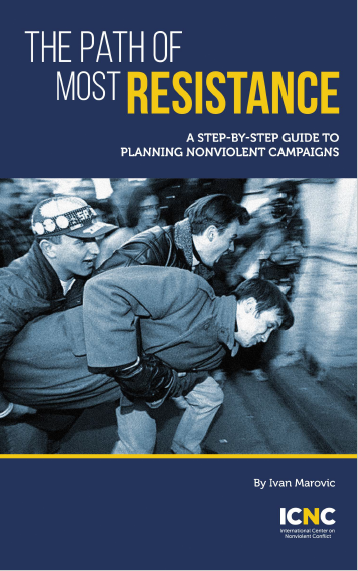Ivan Marovic’s new book on how to plan campaigns is an excellent resource for improving the strategic wisdom of our movements.
By Rivera Sun
Today in the United States, activists and community members are facing scores of pressing social justice issues. The movements are growing in strength and numbers, but what we need isn’t just more hands-on-deck; it’s better strategy for making change.
As an activist and trainer, I’m always on the lookout for manuals that increase our strategic wisdom. I’ve been a resistance manual junkie since before I wrote “The Dandelion Insurrection” and its accompanying study guide to making change. As a trainer, I read everything that comes out, for better or worse. I despise handbooks that limit citizen action to the song-and-dance routines of calling senators, signing petitions and donating to electoral campaigns. I tear my hair out reading the innumerable books that talk only about protest actions. Despite a slew of “protest manuals,” it’s surprisingly difficult to find books with a rigorous understanding of the disruptive, non-cooperative and visionary potentials of civil resistance.
Fortunately, Ivan Marovic’s highly pragmatic, exquisitely useful book, “The Path of Most Resistance: A Step-by-Step Guide to Planning Nonviolent Campaigns” provides an excellent resource for improving the strategic wisdom of our movements. (A free downloadable pdf version has been made available here.) It is perfect for all of us who are working for change, designing a civil resistance campaign, or training people to think strategically.
When I met Marovic at the James Lawson Institute in 2014, he impressed upon me that everyone should understand strategy, not just a handful of campaign organizers or hardcore activists. His experience in Serbia’s youth-led Otpor! movement showed him that when the populace has a widespread working knowledge of basic strategic principles for civil resistance, the chances of successful — and strategically-sound — campaigns increased.
“When everyone knows how to plan,” Marovic said, “you start to get strategic behavior.”
True to this philosophy, Marovic’s new book is designed for activists to take the materials and share them with others. Marovic guides the reader through a step-by-step approach to figuring out the nuts-and-bolts of making change. He concludes with a section on how to take others through a strategic planning process. The manual combines classic strategy tools that activists have used for decades with new understandings and approaches. His “Strengths, Weaknesses, Opportunities, Threats,” or SWOT, analysis tool is one of the more detailed and rigorous I’ve encountered, connecting SWOT insights to scenario development exercises and cost-benefit analysis for both strategy and tactics.
The manual also offers newer tools such as the “Perception Box” exercise, which helps activists analyze opponent, ally, and bystander feelings and beliefs about the issue — showing how to use this knowledge to craft strategic slogans that advance your cause.
“The Path of Most Resistance” links strategic analysis exercises with how to apply the knowledge in resistance campaign designs, which is where many other manuals fall short. In a succinct manner, Marovic’s book covers everything from grand strategy to tactical selection, drawing on years of organizing experience.
And he does it with a lot of humor and wisdom.
“I identified a need in the field for a step-by-step guide allowing individuals to break down a complex nonviolent resistance campaign into a series of manageable steps. A comprehensive guide that would include resources, lesson plans, tools, etc.,” Marovic said in a recent webinar talk about the book, which is worth watching.
His introductory remarks during the webinar include many gems of strategic wisdom, and he offers several highly-illuminating slides that are not in his book. In addition to being an engaging speaker, one of Marovic’s gifts is boiling down complex ideas in understandable — but not oversimplified — ways. He compares strategy for nonviolent campaigns to cooking: If you’re a master chef who knows your ingredients and the nuances of cooking, you can improvise. If you’re like the rest of us, you might want to get to know the fine art of cooking before you try to cater a 100-person dinner. Nonviolent struggle is an equally complex field — with high stakes and a lot of risks — and when it comes to planning campaigns, a lot of us don’t have much experience.
Marovic’s book is to activism what America’s Test Kitchen is to cooking: He distills knowledge from thousands of tests and case studies into basic principles for us to cook up change. He then goes a step further and puts it into nuggets of chapters that we can use as strategic planning exercise with our friends and fellow change-makers.
Check it out. Try it out. Put this step-by-step guide into practice. If you’re tired of going to the same old boring protests, this book is for you. If you’re up against impossible odds, this book is for you. If you have passion and no idea what you’re doing, this book is for you. Strategy is for everyone.
Rivera Sun is a writer and activist syndicated by PeaceVoice. She is the author of “The Dandelion Insurrection” and the sequel, “The Roots of Resistance.” Visit her website: http://www.riverasun.com










